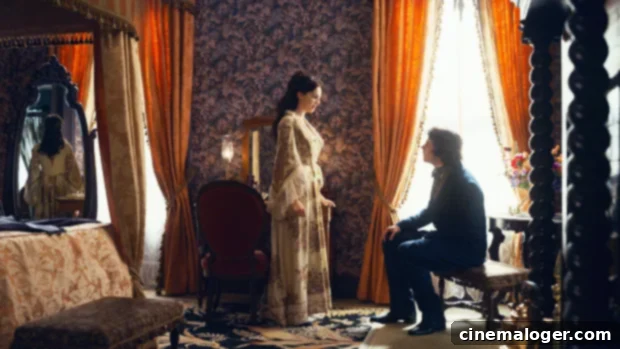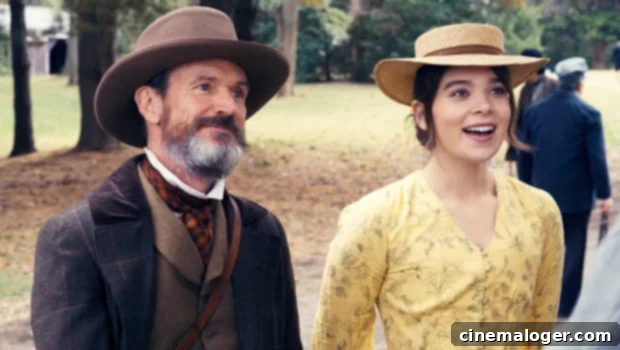Dickinson Season 2 Episode 4: Navigating Writer’s Block, Family Turmoil, and the Lure of Fame
In the captivating fourth episode of Dickinson Season 2, titled “The Rood A.D. – 1849,” the air is thick with frustration, misunderstanding, and existential angst, making it feel like everyone in Amherst is having a profoundly challenging day. At the heart of this turmoil is Emily Dickinson, played brilliantly by Hailee Steinfeld, who awakens with the noble intention of crafting a new poem. Her workspace is meticulously prepared: pencils sharpened to a fine point, crisp paper laid out, an atmosphere of serene expectation. Yet, despite this perfectly curated environment, inspiration remains stubbornly elusive. Emily is gripped by the dreaded affliction known as writer’s block, a profound creative paralysis that leaves her staring at a blank page, her mind a frustrating void.
This creative stagnation soon morphs into a deeper anxiety, prompting Emily to confide in Maggie, the ever-patient maid, in the kitchen. Her thoughts are plagued by a gnawing fear that editor Sam Bowles, a figure of growing importance and influence in her burgeoning literary life, will reject her latest submission. The intensity of her dependency on his approval is highlighted when she refers to him as “my master,” a loaded phrase that echoes the mysterious “Master Letters” found among the real Emily Dickinson’s correspondence, believed by some scholars to be addressed to male mentors or lovers, including possibly Bowles himself. This submission to his judgment leaves her feeling utterly disheartaged, convinced that there’s no longer any point in ever putting pen to paper. Her creative spirit, so vital to her existence, feels suffocated by the external pressure of publication and the fear of a world beyond her control.
Seeking a temporary reprieve from her internal struggles, Emily joins her parents and Maggie in the expansive yard. Their attention is immediately drawn to a rather large, inexplicable hole that “the teens” have dug, a testament to their youthful exuberance and occasional disruptive presence. The situation is exacerbated by the discovery of one of Lavinia’s beloved cats, Drummy Doodles, stranded within the pit. Mrs. Dickinson is, predictably, beside herself with distress, her maternal instincts kicking in to rescue the unfortunate feline. Mr. Dickinson, however, remains remarkably unbothered by the unfolding domestic drama. With a characteristic detachment, he decides to seize the moment, whisking Emily away for a birding excursion. This leaves Mrs. Dickinson to stew in her anxieties, feeling ignored and overwhelmed by the chaos around her, a vivid portrayal of the often-unbalanced dynamics within the Dickinson household.

Meanwhile, back inside the house, Lavinia and Ship are attempting to ignite a romantic spark in her room. Or rather, Lavinia is trying, while Ship appears conspicuously unenthusiastic. His reluctance is palpable as he repeatedly harps on the “improper” nature of their rendezvous, expressing a fear of becoming entangled in another scandalous affair, likening it to the notoriety of Lola Montez, the infamous dancer whose provocative “spider dance” captivated and shocked audiences. Ironically, Ship’s attempts to caution Lavinia by describing Lola’s scandalous allure only serve to heighten Vinnie’s passion and curiosity. When he insists they are moving too quickly, Lavinia, ever the unconventional and assertive Dickinson, retorts with a sharp, “We’re not even engaged!” Her words, intended as a challenge to his reticence, carry a heavy dose of dramatic irony, subtly foreshadowing the dramatic developments awaiting her later in the episode.
Out in the sun-drenched landscape, Edward and Emily, with Emily sporting a truly remarkable straw hat that is an instant fashion envy, stumble upon Austin engrossed in conversation with a distinguished gentleman: Frederick Law Olmsted. For history buffs and urban planners, the name rings immediate bells; this is the same visionary architect who would later become the lead designer of New York City’s iconic Central Park. The show cleverly weaves historical fact with its imaginative narrative, as the real Olmsted, portrayed by Veep star Timothy Simons, was indeed consulted by the Amherst Ornamental Tree Association regarding the town’s common. While historical records don’t definitively confirm a significant journey with Emily around Amherst, Dickinson embraces its artistic license with gusto. Emily, captivated by Olmsted’s creative process and his profound insights into nature and design, is drawn to his magnetic presence and eagerly decides to accompany him as he explores the town, hoping to glean some wisdom for her own artistic struggles.
With Emily otherwise engaged, Austin seizes the opportunity for some much-needed alone time with his father. However, his hopes for a meaningful connection are quickly dashed as Edward continues to lament the unruly “teens” and their perceived terrorization of his home and wife. Austin, ever the pragmatist, offers a solution that he believes will alleviate their domestic woes and bring him closer to his aspirations: he proposes adopting the Newman girls. After all, their substantial inheritance is already funding the construction of his new house. Edward, more than pleased at the prospect of being rid of the boisterous youngsters, readily agrees, much to Austin’s initial excitement. This elation, however, is short-lived as the daunting realization dawns upon him: he still has to break the news to Sue. Back home, Sue, whose character arc in Season 2 sees her becoming increasingly distant and less like the vibrant, empathetic woman Austin, Emily, and the audience fell in love with, reacts with understandable frustration, yet an uncharacteristic coldness when Austin shares his plan. He attempts to reassure her, reiterating his deep desire to be a father and presenting the adoption as the ideal solution for them both – a way to build a family without Sue having to endure childbirth. Sue, resigned to his decision, states that his mind is clearly made up, but adamantly refuses to feign happiness about it. As Austin leaves, she curls up into a small, solitary ball on the sofa, a poignant image of her mounting sadness and isolation.

Elsewhere, Mr. Dickinson’s rather uneventful afternoon takes an unexpectedly dramatic turn when he inadvertently tumbles into the very same massive hole in his yard that the “teens” had excavated. His predicament, repeatedly punctuated by Toby Huss’s comically distressed cries of, “I’m in a hole!” captures a universal feeling of helplessness that resonated strongly with viewers, particularly those who experienced the collective anxieties of 2020. His persistent shouts eventually reach the ears of his wife, who, upon discovering her husband’s undignified situation, makes an astonishing decision: she jumps in with him. This unexpected descent into the pit transforms a comedic mishap into a profound marital therapy session. Mrs. Dickinson seizes the moment to air her long-held grievances, demanding that he stop calling her “Mother” and articulating her deep yearning for the lost passion in their relationship. Edward, in turn, laments their perceived aging, suggesting that youth’s fire has simply dimmed with time. However, Mrs. Dickinson is far from convinced, refusing to accept such a simplistic explanation for their marital stagnation. Despite their ongoing disagreement, they collaborate to get her out of the hole. But when it’s her turn to help him out, in a powerful act of defiance and retribution, she leaves him there, suggesting he use the solitude to truly reflect on her words and the state of their marriage. It’s a striking moment of a wife asserting her voice and demanding to be heard.
Meanwhile, Emily continues her fascinating journey with Frederick Law Olmsted, utterly mesmerized by his unwavering confidence and his profound, insightful opinions on everything, from the intricate beauty of rose bushes to the raw power of ancient rocks. His perspective on the world is a balm to her creatively stifled soul. He proposes they explore a sprawling hedge maze, and as they wander deeper into its verdant labyrinths, Emily’s initial awe gives way to a growing sense of unease that they are becoming disoriented. “Getting lost is the whole point,” Frederick declares with a knowing smile. He elaborates on his philosophy: true creative breakthrough only occurs when one becomes so utterly immersed in a pursuit that they disappear into it, losing all track of time, space, and even themselves. It is in this profound state of disorientation, he suggests, that Emily will rediscover and reclaim her unique creative voice. Yet, as they venture further into the maze’s confusing paths, Emily remains unconvinced, her anxieties persisting. Finally, unable to hold back any longer, she confesses the true source of her creative paralysis. “He holds my life in his hands,” Emily reveals, speaking of Sam Bowles. She vividly articulates her vulnerability with a poignant metaphor: “It’s like I’m the daisy and he’s the sun and without the warmth of his approval, I can’t grow.” Her dependence on his validation has become a suffocating weight.
Frederick, ever the unconventional sage, offers a strikingly simple yet profoundly transformative solution: “Refuse to be the daisy, start being the sun.” With this powerful piece of advice, he mysteriously disappears into the maze, leaving Emily alone and momentarily frightened. Just as despair begins to set in, who should emerge from the labyrinth but Sam Bowles himself. As fate would have it, he has been searching for her all day, eager to deliver the most anticipated news: he loved her poem. He is ready to publish her work, ushering her into the realm of public recognition. However, Emily’s reaction is not one of unbridled joy. She admits to him that she felt profoundly lost today, a sentiment that runs contrary to his vision of her future. Sam, ever focused on external validation and public image, offers a perspective that clashes starkly with Frederick’s counsel: “When you’re famous,” he assures her, “and the whole world can see, you’ll never be able to get lost, ever again.” But for Emily, who has just been advised to embrace getting lost as a path to creativity and to embody her own radiant power rather than seeking it from others, this promise of perpetual visibility and the loss of private wandering is not at all what she yearns to hear. It highlights the growing chasm between her artistic integrity and the demands of fame.
And as for Vinnie, her day culminates in an event that is nothing short of theatrical and utterly bizarre. After a series of increasingly strange encounters, Ship orchestrates a proposal that would rival any dramatic stage production. He enlists the help of his friends to throw a bag over her head, stage a mock kidnapping, drag her out into a field under the watchful eyes of most of the town, unmask her, and then, in front of this captive audience, he proposes marriage. In a moment of classic comedic misunderstanding, Ship misconstrues Vinnie’s stunned silence and wide-eyed gaze at the words “Will You Marry Me” painted grandly on the side of her parent’s barn as an enthusiastic acceptance. Such, indeed, is the beginning of all truly great love stories, right? The episode leaves us with a lingering sense of the absurd and the unexpected, showcasing how each character, in their own unique way, grapples with the pressures and disappointments of life, creativity, and love.
